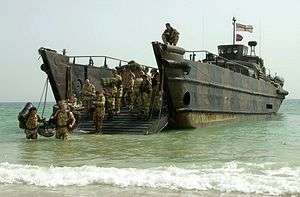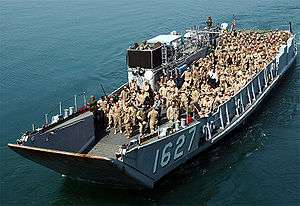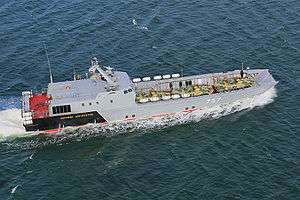Landing Craft Utility
_assigned_to_Amphibious_Craft_Unit_Two_(ACU-2)%2C_rehearse_storming_the_beach_in_Curacao%2C_Netherlands_Antilles.jpg)
The Landing Craft Utility (LCU) is a type of boat used by amphibious forces to transport equipment and troops to the shore. They are capable of transporting tracked or wheeled vehicles and troops from amphibious assault ships to beachheads or piers.
France
The Engin de débarquement amphibie rapide (EDA-R) landing catamaran or L-CAT, entered service in January 2011. They can carry a main battle tank like other European LCUs but are capable of much higher speeds, up to 30 knots (56 km/h; 35 mph).
Germany
Germany has two Barbe-class utility landing craft (Type 520), dating from the mid-1960s, which remain in service under the SEK-M Naval Special Forces' command. Germany is looking to acquire more such crafts. Five Barbe landing crafts were transferred to Greece at the end of the Cold War.
India
.jpg) LCU L53 Launch | |
| Class overview | |
|---|---|
| Name: | LCU MK IV class |
| Builders: | GRSE |
| Operators: |
|
| Preceded by: | LCU Mk III |
| Built: | 2011– |
| Building: | 2 |
| Planned: | 8 |
| Completed: | 6 |
| Active: | 0 |
| General characteristics | |
| Displacement: | 1001 tons[1] |
| Length: | 62.8m |
| Draught: | 1.7m |
| Depth: | 4m |
| Propulsion: | 2 x MTU 16V 4000 M53 marine diesel engines (1,840 kW) with a twin fixed-pitch propeller propulsion system |
| Speed: | 15 kt |
| Range: | 1,500nm at 12 kt |
| Troops: | 160 |
| Complement: | 216 |
| Crew: | 56 |
| Sensors and processing systems: |
|
| Armament: |
|
India currently has six LCUs of the Mk III class and four LCUs of the Mk IV class.
The first Mk III class LCU was commissioned on 18 July 1986.[3]
Netherlands
 | |
| Class overview | |
|---|---|
| Name: | LCU Mk.II (NL) class |
| Operators: |
|
| General characteristics | |
| Type: | Ro-Ro landing craft |
| Displacement: | 255 tonnes (251 long tons) |
| Length: | 36.3 m (119 ft 1 in) |
| Beam: | 6.85 m (22 ft 6 in) |
| Draft: |
|
| Capacity: | 65 tonnes (64 long tons) |
| Complement: | 7 |
| Armament: | 2 × Browning .50 calibre (12.7 mm) machine guns |
With the launch of the amphibious transport ship HNLMS Rotterdam in 1998 there was a need for LCUs. The Dutch LCUs are similar to the British LCU Mk.10 with the bridge being set to one side allowing for a roll-on roll-off design. Until 2005 the Netherlands Marine Corps used the LCU Mark I (NL).
In 2005 and 2006 the five vessels were modernized to the type Mark II. The vessels have been stretched by 9 meters to decrease their draft, which increased their load carrying capacity by 20 tons and allows them to come closer to shore. In addition they were fitted with a strengthened bow ramp, and they can now accommodate the Royal Netherlands Army Leopard 2 A6 main battle tank. Because of the lengthening of the Mark II, the Rotterdam can take two LCUs (plus three LCVPs) in its dock. The dock of Rotterdam's sister ship, HNLMS Johan de Witt, has the capacity to transport two LCUs, but carries four LCVPs in davits.
United Kingdom
 LCU Mk.9 (now retired) | |
| Class overview | |
|---|---|
| Name: | Landing Craft Utility |
| Operators: |
|
| Subclasses: | LCU Mk.9 and LCU Mk.10 |
| Active: | 10 LCU Mk.10s |
| Retired: | LCU Mk.9s |
| General characteristics LCU Mk.10[4] | |
| Displacement: | 240 t (240 long tons; 260 short tons) |
| Length: | 97 ft 10 in (29.82 m) |
| Beam: | 25 ft 3 in (7.70 m) |
| Draught: | 4 ft 11 in (1.50 m) |
| Propulsion: | 2 × MAN D2840 LE diesel engines (400 kW / 2150 r.p.m. each) |
| Speed: | 10 knots (19 km/h; 12 mph) |
| Range: | 600 nautical miles (1,100 km) |
| Capacity: | 1 main battle tank, 4 large vehicles, or 120 troops |
LCU Mk.9
The LCU Mk.9 was built for use on the LPDs Fearless and Intrepid where they were operated from the dock in the rear of the ships.[5] Each ship carried four LCUs and four davit mounted LCVPs. The Mk.9 was to see many changes and upgrades during its service including a move from propeller to jet in many cases. The Mk.9 was capable of traveling as an ocean-going vessel and a number would be converted into a version, affectionately known as the "Black Pig", for use in Norway. The crew had full living quarters aboard with galley and heads. The opinion that the successful British amphibious operations during the Falklands War were only possible because of the two LPDs and their landing craft is well documented. In the Falklands War during the Bluff Cove Air Attacks LCU F4 from Fearless was bombed and sunk in Choiseul Sound by an Argentine Air Force A-4B Skyhawk of Grupo 5.[6] The Mk.9, like the LPDs, served longer than ever anticipated, providing the backbone of Britain's amphibious assault capabilities.
Three Mk.9s, pennant numbers 701, 705, and 709, remained in service by 2012.[5][7] However, by 2014, they had all been withdrawn from service.[8]
LCU Mk.10
The LCU Mk.10 class vessels are operated by the Royal Marines. They are intended for use on board the new assault ships Albion and Bulwark and can use the Bay class landing ships. Deliveries of the class started from 1998 and the fleet currently consists of ten vessels, bearing pennant numbers 1001 to 1010. Both Albion and Bulwark are capable of carrying 4 LCU's. These vessels are capable of operating independently for up to 14 days with a range of 600 nautical miles. They are capable of operating world-wide, from Arctic operating areas to tropical operating areas. The Mk.10 differs greatly from the Mk.9 with the bridge being set to the side allowing for a roll-on roll-off design. This greatly increases efficiency over the old Mk.9 as loading of the rear LCUs can take place without the LCUs being launched, the LPD having to dock down to do so, to change over and load up, which was a problem prior to the Falklands landings. The LCU Mk.10 has a 7-man crew and can carry up to 120 Marines or alternatively 1 battle tank or 4 lorries. British assault ships also carry smaller LCVPs on davits to transport troops and light vehicles.
All ten Mk.10s, pennant numbers 1001 to 1010, remain in service as of 2012.[7]
United States
LCU 1466, 1610 and 1627 classes
 LCU-1627 | |
| Class overview | |
|---|---|
| Name: | LCU 1466, 1610 and 1627 classes |
| Operators: |
|
| Active: | 32[9] |
| General characteristics | |
| Displacement: | see table |
| Length: | see table |
| Beam: | see table |
| Draft: | see table |
| Propulsion: | see table |
| Speed: | see table |
| Range: | see table |
| Endurance: | 10 days[9] |
| Capacity: | see table |
| Troops: | see table |
| Sensors and processing systems: | LN 66 or SPS-53 I band navigation radar |
| Armament: | 2 × Browning .50 caliber machine guns |
The LCU 1466, 1610 and 1627 class vessels are operated by the United States Navy at support commands.[10][11] They are a self-sustaining craft complete with living accommodations and messing facilities for a crew of thirteen.[9] They have been adapted for many uses including salvage operations, ferry boats for vehicles and passengers, and underwater test platforms. Each LCU is assigned a non-commissioned-officer-in-charge (NCOIC) (Craft Master) who is either a Chief Petty Officer or Petty Officer First Class in the Boatswain’s Mate, Quartermaster or Operations Specialist rating. These vessels have bow ramps for onload/offload, and can be linked bow to stern gate to create a temporary pier-like structure. Its welded steel hull provides high durability with deck loads of 800 pounds per square foot. Arrangement of machinery and equipment has taken into account built-in redundancy in the event of battle damage. The craft features two engine rooms separated by a watertight bulkhead to permit limited operation in the event that one engine room is disabled. An anchor system is installed on the starboard side aft to assist in retracting from the beach. These vessels are normally transported to their areas of operation onboard larger amphibious vessels such as LHDs and LHAs. The 40-year-old craft will be replaced under the Surface Connector (X) Recapitalization, or SC(X)R, project starting in FY2017.[9]
| [10][11] | LCU 1466 | LCU 1610 | LCU 1627 |
|---|---|---|---|
| Displacement - light | 180 long tons (183 t) | 172 long tons (175 t) | 190 long tons (193 t) |
| Displacement - full | n/a | 353 long tons (359 t) | 405 long tons (411 t) |
| Length overall | 115 ft 1 in (35.08 m) | 135 ft 3 in (41.22 m) | 116 ft 6 in (35.51 m) |
| Beam | 34 ft 0 in (10.36 m) | 29 ft 0 in (8.84 m) | 34 ft 0 in (10.36 m) |
| Draft - full load, forward | 6 ft 0 in (1.83 m) | 4 ft 10 in (1.47 m) | 6 ft 9 in (2.06 m) |
| Draft - full load, aft | 2 ft 9 in (0.84 m) | 3 ft 6 in (1.07 m) | 3 ft 6 in (1.07 m) |
| Power - sustained | 675 hp (503 kW) | 1,000 hp (746 kW) | 680 hp (507 kW) |
| Propulsion | 3 x Gray Marine diesel engines | 2 x Detroit 12V-71 diesel engines | 4 x Detroit diesel engines |
| Shafts | 3 | 2 | 2 |
| Speed | 8 knots (15 km/h; 9.2 mph) | 11 knots (20 km/h; 13 mph) | 8 knots (15 km/h; 9.2 mph) |
| Range | 1,200 nmi (2,200 km) at 6 kn (11 km/h) | 1,200 nmi (2,200 km) at 8 kn (15 km/h) | 1,200 nmi (2,200 km) at 6 kn (11 km/h) |
| Complement | 14 | 14 | 12-14 |
| Capacity - troops | 300 | 400 | 350 |
| Capacity - cargo | 167 long tons (170 t) | 180 long tons (183 t) | 170 long tons (173 t) |
LCU 2000
.jpg) | |
| Class overview | |
|---|---|
| Name: | LCU 2000 class |
| Operators: |
|
| General characteristics | |
| Displacement: |
|
| Length: | 174 ft (53 m) |
| Beam: | 42 ft (13 m) |
| Draft: |
|
| Speed: | 11.5 knots (21.3 km/h; 13.2 mph) |
| Range: | |
| Capacity: |
|
| Complement: | 13 |
The Runnymede class large landing craft or LCU 2000 class vessels are operated by the United States Army.[12][13] They transport rolling and tracked vehicles, containers, and outsized and general cargo from ships offshore to shore, as well as to areas that cannot be reached by oceangoing vessels (coastal, harbor, and intercoastal waterways). It can be self-deployed or transported aboard a float-on/float-off vessel. It is classed for full ocean service and one-man engine room operations and is built to U.S. Coast Guard standards. The vessel can sustain a crew of 2 warrant officers and 11 enlisted personnel for up to 18 days, and 10,000 miles. This class is also equipped with an aft anchor to assist in retracting from the beach.

Russia
Dyugon
 | |
| Class overview | |
|---|---|
| Name: | Dyugon-class landing craft |
| Operators: |
|
| General characteristics | |
| Displacement: |
|
| Length: | 169 ft (52 m) |
| Beam: | 36 ft (11 m) |
| Draft: |
|
| Speed: | 35 knots (65 km/h; 40 mph) |
| Range: | |
| Capacity: |
|
| Complement: | 7 |
| Armament: | 2 KPV 14.5 mm machine guns |
The Dyugon-class landing craft are operated by the Russian Navy
Spain
 L-602 | |
| Class overview | |
|---|---|
| Name: | LCM-1E |
| Builders: | Navantia |
| Operators: | |
| Preceded by: | LCM-8 |
| Planned: | 30 |
| Completed: | 26 |
| Active: | 24 |
| Retired: | 2 |
| General characteristics | |
| Type: | Roll-on/roll-off landing craft mechanised |
| Displacement: |
|
| Length: | 23.3 metres (76 ft) |
| Beam: | 6.4 metres (21 ft) |
| Draught: | 1 metre (3 ft 3 in) loaded |
| Ramps: | Bow ramp and stern gate |
| Propulsion: |
|
| Speed: |
|
| Range: | 190 nautical miles (350 km; 220 mi) at economic speed |
| Capacity: |
|
| Complement: | 4 |
The Armada has 26 LCM-1E in service since 2001 and has been exported to Australia and Turkey.
In literature
Cap'n Fatso is the second book in a series of three by Daniel V. Gallery that feature Boatswains Mate First Class John "Fatso" Gioninni. Fatso is the commander of an LCU that, while on a special supply errand for his LSD's captain, is left behind in the Mediterranean Sea when the whole Sixth Fleet unexpectedly leaves for Vietnam. Through a series of accidents and misunderstandings Fatso and his crew are left without orders or attachment to any fleet and decide to "search the Mediterranean Sea for the Sixth Fleet". Hilarity ensues when they play practical jokes on the Russian fleet and make an "official" visit to Israel during the Six-Day War.[14]
References
- ↑ http://www.janes.com/article/64321/indian-navy-receives-first-of-new-class-of-mk-iv-lcus
- ↑ http://www.janes.com/article/64321/indian-navy-receives-first-of-new-class-of-mk-iv-lcus
- ↑ http://www.indiannavy.nic.in/content/kumbhir-class-lcu-mk-3-class
- ↑ "Landing Craft LCU MK 10" (PDF). Schottel.de. Retrieved 2015-07-18.
- 1 2 The Royal Navy Handbook, page 106
- ↑ http://www.naval-history.net/F62-Falklands-British_ships_lost.htm
- 1 2 "The Military Balance 2012", International Institute for Strategic Studies, pp. 170-171
- ↑ Bush, Steve (2014). British Warships and Auxiliaries. Maritime Books. pp. 35–39. ISBN 1904459552.
- 1 2 3 4 Scott, Richard (28 January 2013). "US scopes objectives for new surface connector workhorse". Jane's Navy International.
- 1 2 Friedman, Norman (2002). U.S. Amphibious Ships and Craft: An Illustrated Design History. Annapolis MD: Naval Institute Press. p. 390. ISBN 1557502501. Retrieved 19 July 2015.
- ↑ Marge Holtz, Lisa Gates (October 29, 1998). "Creative thinking offers stowage solution". Military Sealift Command. Retrieved 2008-02-03.
- ↑ Spc. Morrene E. Randell (5 September 2007). "Army Boat Supports Dive Teams Trying to Raise Russian Sub". army.mil.
- ↑ Cap'n Fatso (Norton, 1969)
External links
- Royal Marines - Landing Craft (royalnavy.mod.uk)
 Media related to Landing craft utility at Wikimedia Commons
Media related to Landing craft utility at Wikimedia Commons